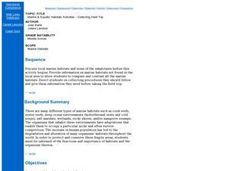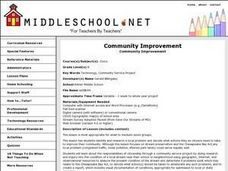Curated OER
Animal Habitats
Students study the word habitat and its meaning. They also identify that in order for something to be classified as a habitat there needs to be the proper shelter, food, water, and space.
Curated OER
Hunt for Habitats
Students review components of a habitat and go on a hike around a pond and woods exploring different habitats and the plants and animals that use them. They examine mammal pelts and discuss the life histories, adaptations, and positions...
Curated OER
Watch Over Wild Wanders
Students collect and organize data relating to migratory species and habitats; undertake a habitat action plan, then maintain planting and building projects for continuing benefit to wildlife; understand the unique needs of migratory...
Curated OER
Geese and Sandhill Cranes of Nebraska
Young scholars gather information on the geese and cranes found in Nebraska. Students explore ways they can help save their habitats. Also, young scholars use additional general information they connect artwork to their research topic.
Curated OER
In Your Own Backyard
Young scholars observe organisms in their habitat and record their observations. They then draw conclusions about the organism's habitat needs and food sources.
Curated OER
Endangered Spaces = Endangered Species!
Sixth graders discuss the crowding, loss of personal space, loss of home, loss of food, etc. that might occur at a developmental site. They witness, through an in-class demonstration, what happens when land is taken for development. They...
Curated OER
The Elephant Ate a Banana in the Tundra
Students perform a scene with their small group. They identify an animal, act out what the animal does, where the animal would be found, and what the animal eats. They locate the animal habitats on a map.
Curated OER
The Magic School Bus Gets Swamped
Students participate in an experiment that shows them how wetlands filter dirty water. They work in groups to accomplish this experiement with the help of supervisors. A bulletin board can be created to show the plants and animals that...
Curated OER
Estuarine Habitats
Sixth graders study the important habitats, flora, fauna, and physical factors of coastal habitats. They compare the aquatic habitats to terrestrial habitats by researching and completing tables with the information.
Curated OER
Collecting Field Trip
Students identify and describe each marine habitat. They name organisms that can be found in each habitat and discover ways in which to protect them. They participate in an activity to complete the lesson.
Curated OER
Home S-s-sweet Home The Eastern Massasauga Rattlesnake
Young scholars investigate the eastern massasauga rattlesnake's habitat. They examine how the habitat allows the snake to survive by completing a variety of activities.
Curated OER
Eelgrass Bed Exploration
Students study the function and biological value of eelgrass beds. They discover the habitat requirements of the beds by reading a hand-out and completing a worksheet.
Curated OER
Keep It Complex!
Students describe the significance of complexity in benthic habitats to organisms that live in these habitats.Students describe at least three attributes of benthic habitats that can increase the physical complexity of thes
Curated OER
Puzzling Planets
Students list the order of the planets, describe the general characteristics of each planet and explain why we could not live on other planets without special equipment.
Curated OER
Mississippi Gulf Coast Islands
Fourth graders complete a variety of exercises as they study the creation, history, and geography of the Mississippi coastal islands. They discover the natuaral forces that act on the islands and how these forces affect the habitats and...
Curated OER
Land Use Issues
Students research the different habitats found in the world. They also examine the land use issues that affect each of the habitats. They also research any environmental issues affecting the habitat they are researching.
Curated OER
Hole Homes
Students make predictions regarding appearances of animal homes through observation, comparison, and evaluation of a habitat.
Curated OER
Grizzly Habitat
Pupils find areas on playground where they would live if they were a grizzly bear, share their reasons for their choice, talk about habitat areas, and choose their sites again, based upon new information.
Curated OER
"Habitats"
Students complete a unit of lessons on animals and animal conservation. They observe a square meter of ground outside the school, set up a model environment, analyze an owl pellet, grow bread mold, and explore various websites.
Curated OER
Lewis and Clark in Washington Shrub Steppe Habitat
Students examine the land of the shrub steppe and compare it with Lewis and Clark's journals. They list the characteristics of the land. They also discuss restoration of native plants.
Curated OER
Habitat Breakdown
Fourth graders gain an understanding of how insects/organisms are impacted by factors that are essential to an organism's survival in a particular habitat. They see how lacking just one element of a habitat can affect an organisms chance...
Curated OER
Wolf Habitat
Students identify their own basic needs for food, water, shelter and space in a suitable arrangement. They generalize that wolves and people have similar basic needs.
Curated OER
Habitat Lap Sit
Fourth graders physically form a circle that shows the interconnectedness of the components of a habitat. They form circles and role play the parts of habitats.
Curated OER
Community Improvement
Young scholars examine a local body of water to determinet the health of its ecosystem and monitor it during the year. If needed they write a report on any conditions that need improvement including photographs and relevant data.

























